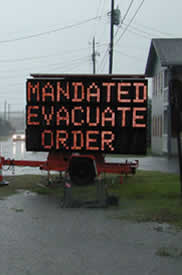Printable Version [PDF 2.4 MB]
To view PDF files, you need the Adobe Acrobat Reader.
Contact Information: Operations Feedback at OperationsFeedback@dot.gov.
Literature Search for Federal Highway Administration
Assessment of State of the Practice and State of the Art in Evacuation Transportation Management |
   |

February 7, 2006
Produced in collaboration with the
Intelligent Transportation Systems Joint Program Office (ITS JPO)
Images courtesy of the Federal Emergency Management Agency (FEMA)
Credits: Ed Edahl (left), Leif Skoogfors (center), Dave Gatley (right) |
Technical Report Documentation Page
Table of Contents
1 Executive Summary
1.1 Key Issues and Findings
1.2 Lessons Learned
1.3 Best Practices
1.4 Tools
2 Introduction
3 Methodology for Literature Search
3.1 Collection of Relevant Documents
3.2 Review and Analysis of Information
4 Findings
4.1 Common Themes from the Analysis of the Available Literature
4.2 Issues Regarding Evacuations
4.2.1 Nature of the Hazard
4.2.1.1 Chaotic Nature of Evacuations
4.2.1.2 Enforcement of Evacuation Orders
4.2.1.3 Evacuation Decisions
4.2.1.4 Evacuation Management
4.2.1.5 Getting People to Evacuate
4.2.1.6 Impacts of and to Transportation Systems
4.2.1.7 Awareness of the Hazard
4.2.1.8 Nighttime Evacuations
4.2.1.9 Response to Hazard
4.2.2 Transportation Objectives
4.2.2.1 Areas to Avoid
4.2.2.2 Critical Facilities
4.2.2.3 Destinations – Potential Routes
4.2.2.4 Distance for Evacuation
4.2.2.5 Emergency Plans
4.2.2.6 Evacuee Locations
4.2.2.7 Managing Traffic and People
4.2.2.8 Number of Vehicles Involved in Evacuations
4.2.2.9 Planning for Evacuee and Personnel Return
4.2.2.10 Redundant Systems
4.2.2.11 Use of Transit
4.2.3 Infrastructure Issues
4.2.3.1 Loss of Infrastructure
4.2.3.2 Monitoring of Critical Routes
4.2.3.3 Reverse Flow – Contra-Flow Lanes
4.2.3.4 Staging of Resources
4.2.3.5 Transit Infrastructure
4.2.3.6 Use of ITS
4.2.3.7 Work Zones
4.2.4 Coordination Issues
4.2.4.1 Contingency Planning
4.2.4.2 Cooperation
4.2.4.3 Evacuation Coordination
4.2.4.4 Incident Command System
4.2.4.5 Mutual Aid and Other Agreements
4.2.4.6 Training
4.2.4.7 Unified Command
4.2.4.8 Use of Specialty Teams
4.2.5 Communication Issues
4.2.5.1 Communication Devices
4.2.5.2 Demand for Travel Information
4.2.5.3 Difficult Communication Incidents
4.2.5.4 Information Sources
4.2.5.5 Need for Communication
4.2.5.6 Redundancies in the System
4.2.5.7 Information Sharing
4.2.5.8 Communication Staging
4.2.6 Special Needs
4.2.6.1 Evacuation of Special Needs Evacuees
4.2.6.2 Accommodations for Special Need Evacuees
4.2.6.3 Location of Special Need Shelters
4.2.6.4 Evacuation of Special Need Facilities
4.2.6.5 Evacuees with Pets or Animals
4.2.6.6 Pedestrians
4.2.6.7 Bicyclists
4.2.6.8 Truckers
4.2.7 Changing Conditions
4.2.7.1 Changing Priorities
4.2.7.2 Responsibility for the Changing Priorities
4.2.8 Impacts to Transportation Systems Due to Evacuation
4.2.8.1 Transportation Impacts Due to Closure of Manufacturing Plants
4.2.8.2 Coordination for Reentry
4.2.8.3 Impact of Transit Decisions
4.2.8.4 Traffic Management Plans for Evacuations
5 Lessons Learned
5.1 Advanced Preparations and Planning
5.1.1 Agreements/Plans/Procedures
5.1.2 Planning
5.1.3 Practice
5.1.4 Preparation for the Future
5.1.5 Advanced Preparations and Planning – Public Transit
5.2 Advanced Technology
5.2.1 Communication
5.2.2 Facilities
5.2.3 Power
5.3 Command and Control
5.3.1 Community Protection Incident Management Teams
5.3.2 Unified Command and Liaison/Emergency Operations Center Integration
5.4 Communication
5.4.1 Agencies
5.4.2 Alternative Means
5.4.3 Alternative Technology
5.4.4 Equipment
5.4.5 Information Management
5.4.6 Internal
5.4.7 Joint Information Center
5.4.8 Media
5.4.9 Phone Service
5.4.10 Public Education
5.4.11 Public Notification
5.4.12 Radio
5.4.13 Strategy
5.4.14 Systems Interoperability
5.4.15 Traveler Information
5.5 Cooperation
5.6 Coordination
5.6.1 Agencies/Private Sector
5.6.2 Relationships
5.7 Emergency Plans
5.8 Evacuations
5.8.1 Dispatch Organization
5.8.2 Evacuation Decision Making
5.8.3 Evacuation Management
5.8.4 Evacuation Plans
5.8.5 Evacuation Procedures
5.8.6 Evacuation Routes
5.8.7 Evacuation Traffic Management
5.8.8 Exercising of Individual Initiative
5.8.9 Evacuations – Guiding Priority
5.8.10 Evacuations – Route Control
5.9 Operations
5.9.1 Advanced Technology
5.9.2 Highway
5.9.3 Procedures
5.9.4 Resources
5.9.5 Staff
5.9.6 Volunteers
5.10 Redundancy and Resiliency of Systems
5.10.1 Backup Facilities/Power
5.10.2 Communication
5.10.3 Regional Transportation Network
5.10.4 Redundancy and Resiliency of Systems – Supplies
5.11 Training
5.11.1 Training – Interagency Training
6 Best Practices
6.1 Advanced Preparation and Planning
6.2 Advanced Technology
6.3 Communication
6.3.1 Maps
6.4 Cooperation
6.5 Coordination
6.6 Evacuations
6.6.1 Evacuation Management
6.6.2 Evacuation Plan
6.6.3 Evacuation Procedures
6.6.4 Evacuation Routes
6.7 Operations
6.8 System Redundancy and Resiliency
6.9 Training and Planning
6.10 Transportation Emergency Response Checklist
7 Potential Tools
7.1 Integrated Corridor Management
7.2 Evacuation Planning
7.3 Evacuation Routing
7.4 Identification of Hazardous Materials and Manifest
7.5 Identification of Infrastructure Utilizing GIS
7.6 Identification of Evacuation Routes
7.7 Informing People of the Need to Evacuate
7.8 Interoperable Communications
7.9 Location of Public Transit Buses and Rail Systems
7.10 Traffic Monitoring in Rural Areas or Blackout Areas
Appendix A: Literature Search
INDEX
NOTICE
This document is disseminated under the sponsorship
of the Department of Transportation in the interest
of information exchange. The United States Government
assumes no liability for its contents or use thereof.
This report does not constitute a standard, specification,
or regulation.
The United States Government does not endorse
products or manufacturers. Trade and manufacturers’
names appear in this report only because they are
considered essential to the object of the document.
Contact Information
For additional information on this report, contact Operations Feedback, via e-mail at OperationsFeedback@dot.gov.

U.S. Department of Transportation
Federal Highway Administration
Office of Operations
1200 New Jersey Avenue, SE
Washington, DC 20590
ops.fhwa.dot.gov
February 7, 2006
Publication #FHWA–HOP-08-015